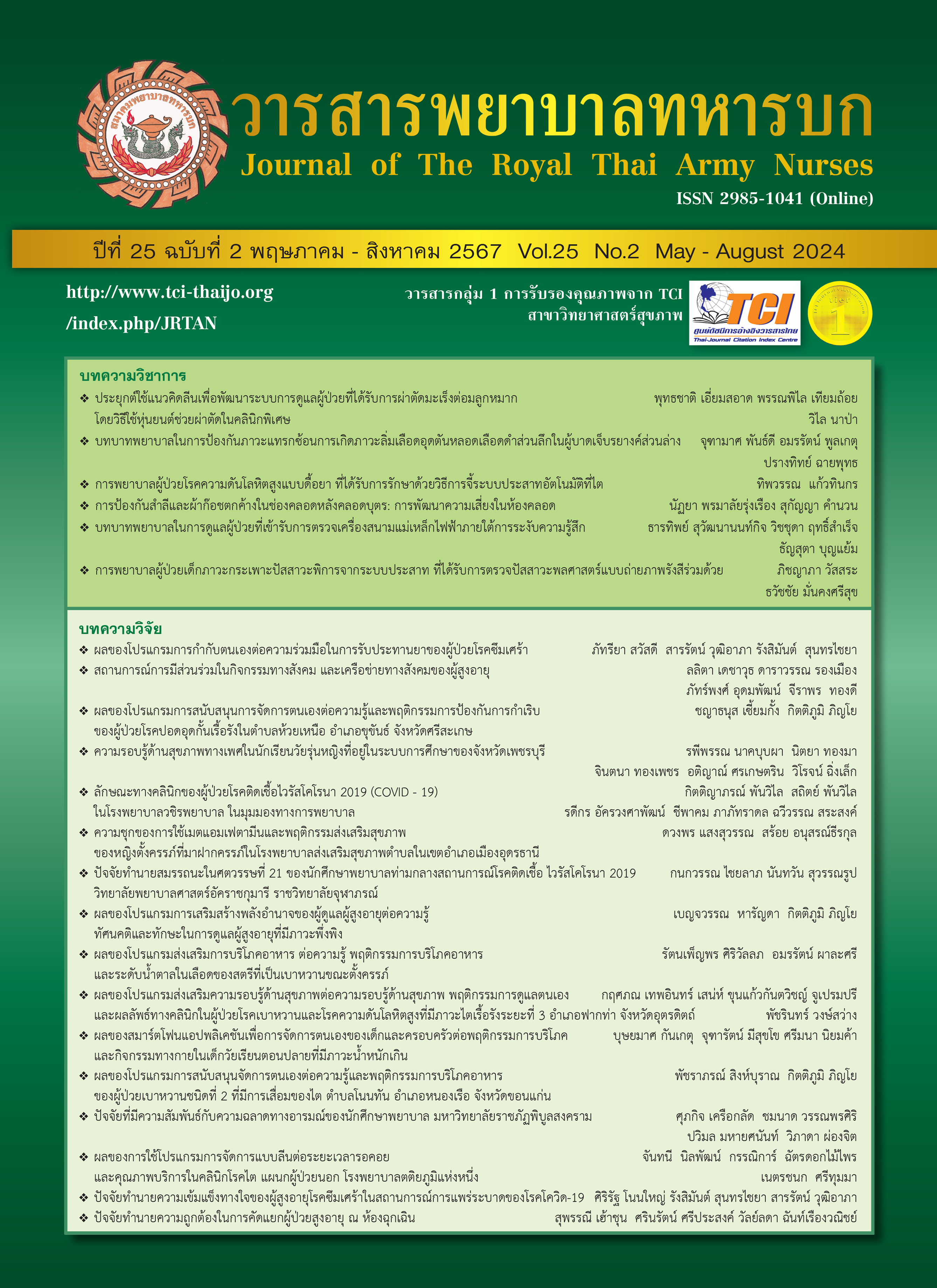Clinical Characteristics of Coronavirus Disease 2019 (COVID-19) Patients in Vajira Hospital in Nursing Perspective
Keywords:
Clinical characteristics, Infected patient, COVID-19, Nursing perspectiveAbstract
In late 2019, there was a report of a cluster of unfamiliar pneumonia cases emerged in Wuhan, China, which then identified SARS-CoV-2 as the causative agent of COVID-19. This study aimed to study the clinical characteristics of COVID-19 patients in the Vajira Hospital and follow the data of critical COVID-19 patient to be informative for nursing. The study design was a retrospective descriptive study and relied on purposive sampling that was collected in record form from August to September 2020. We described clinical, demographic, radiological, and laboratory findings as well as followed the medical history of a critical COVID-19 patient. The results showed that there were seven patients with a median age of 35, comprising five men and two women. Two male patients developed severe disease, and one progressed to critical COVID-19. The chief complaints included cough, sore throat, fever, shortness of breath, and rhinorrhea. Both severe patients exhibited biomarkers indicating acute inflammation in the body. Notably, the patient with no comorbidities developed critical symptoms. The result of critical COVID-19 found that clinical characteristics encompassed ARDS, AGE, GIH, colitis, coffee-ground emesis, as well as MPC, and GGO. The following result revealed that most COVID-19 patients in our study presented with mild illness, while critical COVID-19 symptoms did not exhibit any identifiable risk factors. These results contribute to understanding the clinical characteristics of COVID-19 patients, enhancing the knowledge and management of nurses for handling the COVID-19 situation specifically according to an urban context and lifestyle.
Downloads
References
Huang C, Wang Y, Li X, et al. Clinical features of patients infected with 2019 novel coronavirus in Wuhan, China [published correction appears in Lancet. 2020 Jan 30]. Lancet. 2020; 395(10223): 497-506.
WHO COVID-19 Dashboard [Internet]. Geneva: World Health Organization, 2020.
Fani M, Teimoori A, Ghafari S. Comparison of the COVID-2019 (SARS-CoV-2) pathogenesis with SARS-CoV and MERS-CoV infections. Future Virology. 2020; 15(5)2020-50.
da Rosa Mesquita R, Francelino Silva Junior LC, Santos Santana FM, et al. Clinical characteristics of COVID-19 in the general population: systematic review. Wiener klinische Wochenschrift. 2021; 133(7): 377-82.
Preskorn SH. The 5% of the Population at High Risk for Severe COVID-19 Infection Is Identifiable and Needs to Be Taken into Account When Reopening the Economy. Journal of Psychiatric Practice. 2020; 26(3): 219-27.
Sathira-AngkuraT,LeelawongS,Amonprompukdee A, Janta-Um-Mou U. Driving the Operation of the Nurse Collaboration Center in COVID-19 Outbreak. Journal of The Royal Thai Army Nurses. 2021; 22(1): 83-91. (in Thai)
Okada P, Buathong R, Phuygun S, et al. Early transmission patterns of coronavirus disease 2019 (COVID-19) in travellers from Wuhan to Thailand, January 2020. Eurosurveillance. 2020; 25(8): 2000-97.
Dechsupa S, Assawakosri S, Phakham S, Honsawek S. Positive impact of lockdown on COVID-19 outbreak in Thailand. Travel Medicine and Infectous Disease. 2020; 36(1): 101-802.
Cao Z, Li T, Liang L, et al. Clinical characteristics of Coronavirus Disease 2019 patients in Beijing, China. PLoS One. 2020; 15(6): 234-764.
Kolta MF, Ghonimy MBI. COVID-19 variant radiological findings with high lightening other coronavirus family (SARS and MERS) findings: radiological impact and findings spectrum of corona virus (COVID-19) with comparison to SARS and MERS. The Egyptian Journal of Radiology and Nuclear Medicine. 2020; 51(1): 1-8.
Liu K, Chen Y, Lin R, Han K. Clinical features of COVID-19 in elderly patients: A comparison with young and middle-aged patients. Journal of Infectous. 2020; 80(6): 14-8.
Tartof SY, Qian L, Hong V, et al. Obesity and Mortality Among Patients Diagnosed With COVID-19: Results from an Integrated Health Care Organization. Annals of Internal Medicine. 2020; 173(10): 773-81.
Sanyaolu A, Okorie C, Marinkovic A, et al. Comorbidity and its Impact on Patients with COVID-19. SN Comprehensive Clinical Medicine. 2020; 2(8): 1069-76.
He Q, Zhang G, Gu Y, et al. Clinical Characteristics of COVID-19 Patients With Pre-existing Hepatitis B Virus Infection: A Multicenter Report. The American Journal of Gastroenterology. 2020; 116(2): 420-21.
Liu R, Zhao L, Cheng X, et al. Clinical characteristics of COVID-19 patients with hepatitis B virus infection - a retrospective study. Liver International. 2020; 41(4): 720-30.
Liu F, Li L, Xu M, et al. Prognostic value of interleukin-6, C-reactive protein, and procalcitonin in patients with COVID-19. Journal of Clinical Virology. 2020; 127(20): 1-5.
Zhang XW, Yap YL. The 3D structure analysis of SARS-CoV S1 protein reveals a link to influenza virus neuraminidase and implications for drug and antibody discovery. Theochem. 2004; 681(1): 137-41.
Tan Q, Duan L, Ma Y, et al. Is oseltamivir suitable for fighting against COVID-19: In silico assessment, in vitro and retrospective study. Bioorganic Chemistry. 2020; 104(12): 1042-57.
Shiraki K, Daikoku T. Favipiravir, an anti-influenza drug against life-threatening RNA virus infections. Pharmacology and Therapuutic. 2020; 209(5): 107-12.
Coomes EA, Haghbayan H. Favipiravir, an antiviral for COVID-19? Journal of Antimicrobial Chemotherapy. 2020; 75(7): 2013-14.
Wang M, Cao R, Zhang L, et al. Remdesivir and chloroquine effectively inhibit the recently emerged novel coronavirus (2019-nCoV) in vitro. Cell Research. 2020; 30(3): 269-71.
Takla M, Jeevaratnam K. Chloroquine, hydroxychloroquine, and COVID-19: Systematic review and narrative synthesis of efficacy and safety. Saudi Pharmaceutical Journal. 2020; 28(12): 1760-76.
Javorac D, Grahovac L, Manić L, et al. An overview of the safety assessment of medicines currently used in the COVID-19 disease treatment. Food Chemical Toxicology. 2020; 144(1): 1-7.
Krajangpho S. Effectiveness of Program for Improving Self-Care Behaviors to Prevent COVID-19 of Communities among Village Health Volunteers in Pathumthani Province. Journal of The Royal Thai Army Nurses. 2021; 22(3): 479-87. (in Thai).
Downloads
Published
How to Cite
Issue
Section
License
Copyright (c) 2024 Journal of The Royal Thai Army Nurses

This work is licensed under a Creative Commons Attribution-NonCommercial-NoDerivatives 4.0 International License.
บทความหรือข้อคิดเห็นใดใดที่ปรากฏในวารสารพยาบาลทหารบกเป็นวรรณกรรมของผู้เขียน ซึ่งบรรณาธิการหรือสมาคมพยาบาลทหารบก ไม่จำเป็นต้องเห็นด้วย
บทความที่ได้รับการตีพิมพ์เป็นลิขสิทธิ์ของวารสารพยาบาลทหารบก
The ideas and opinions expressed in the Journal of The Royal Thai Army Nurses are those of the authors and not necessarily those
of the editor or Royal Thai Army Nurses Association.






